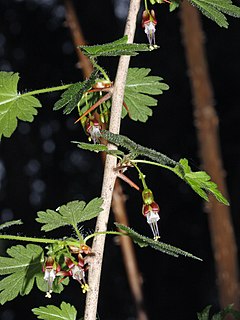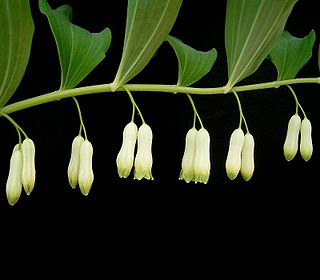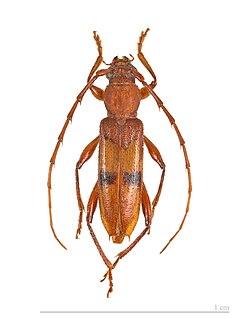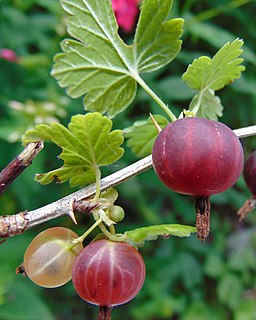Related Research Articles

The flowering plant genus Ipheion belongs to Allioideae, a subfamily of the family Amaryllidaceae. The World Checklist of Selected Plant Families no longer recognize the genus, regarding it as a synonym of Tristagma, although The Plant List accepts two species.

Ribes is a genus of about 200 known species of flowering plants, most of them native to the temperate regions of the Northern Hemisphere. The various species are known as currants or gooseberries, and some are cultivated for their edible fruit or as ornamental plants. Ribes is the only genus in the family Grossulariaceae.

The longhorn beetles (Cerambycidae), also known as long-horned or longicorns, are a large family of beetles, with over 35,000 species described. Most species are characterized by extremely long antennae, which are often as long as or longer than the beetle's body. In various members of the family, however, the antennae are quite short and such species can be difficult to distinguish from related beetle families such as the Chrysomelidae. The scientific name of this beetle family goes back to a figure from Greek mythology: after an argument with nymphs, the shepherd Cerambus was transformed into a large beetle with horns.

Polygonatum, also known as King Solomon's-seal or Solomon's seal, is a genus of flowering plants. In the APG III classification system, it is placed in the family Asparagaceae, subfamily Nolinoideae. It has also been classified in the former family Convallariaceae and, like many lilioid monocots, was formerly classified in the lily family, Liliaceae. The genus is distributed throughout the temperate Northern Hemisphere. Most of the approximately 63 species occur in Asia, with 20 endemic to China.

The Chrysomeloidea are an enormous superfamily of beetles, with tens of thousands of species, mostly in the families Cerambycidae and Chrysomelidae, the leaf beetles.

Lamiinae, commonly called flat-faced longhorns, are a subfamily of the longhorn beetle family (Cerambycidae). The subfamily includes over 750 genera, rivaled in diversity within the family only by the subfamily Cerambycinae.

The Disteniidae are a small family of beetles in the superfamily Chrysomeloidea, traditionally treated as a group within the Cerambycidae.

Eriogonum hirtellum is a species of wild buckwheat known by the common name Klamath Mountain buckwheat. It is endemic to the Klamath Mountains of far northern California, where it is known from only a few occurrences.
Gooseberry most often refers to a cultivated plant from two species of the genus Ribes:

Ribes inerme is a species of currant known by the common names whitestem gooseberry and white stemmed gooseberry. It is native to western North America from British Columbia to California and westward to the Rocky Mountains. It grows in mountain forests, woodlands, and meadows.
Funastrum is a genus of flowering plant now in the family Apocynaceae. The name is derived from the Latin word funis, meaning "rope", and astrum, alluding to the twining stems. Members of the genus are commonly known as twinevines.

Elaphidiini is a tribe of beetles in the subfamily Cerambycinae, containing the following genera:
Trachyderini is a tribe of long-horned beetles in the family Cerambycidae. There are at least 140 genera and 650 described species in Trachyderini.
Lepturgantes is a genus of beetles in the family Cerambycidae, containing the following species:

Ribes hirtellum is a species of gooseberry commonly known as wild gooseberry or swamp gooseberry. It is native to Canada and the northern United States. Cultivated gooseberries are derived from this species and from Ribes uva-crispa.
Beauverdia is a genus of South American plants in the onion subfamily within Amaryllis family, native to Brazil, Uruguay, and Argentina. The plants are bulb-forming perennial herbs.
Dmytro Zajciw was a Ukrainian and Brazilian entomologist, notable for his collection and for his many beetle discoveries. He was born in Velyka Mykhailivka, Ukraine and died in Rio de Janeiro, Brasil. He was the author of Two new genera and species of neotropical Longhorn beetles , 1957, Contribution to the study of Longhorn beetles of Rio de Janeiro , 1958, and was the first to describe the genera Adesmoides and Pseudogrammopsis, as well as the species Beraba angusticollis and Mionochroma subaurosum, among many others.
Heterocentron is a genus of flowering plants belonging to the family Melastomataceae.
Peponium is a genus of flowering plants belonging to the family Cucurbitaceae.
References
- ↑ "Aetheibidion hirtellum (Gounelle, 1913)". Cerambycidae of the World. Retrieved February 26, 2015.
- ↑ Bezark, Larry G. A Photographic Catalog of the Cerambycidae of the World Archived 2013-08-27 at the Wayback Machine . Retrieved on May 22, 2012.